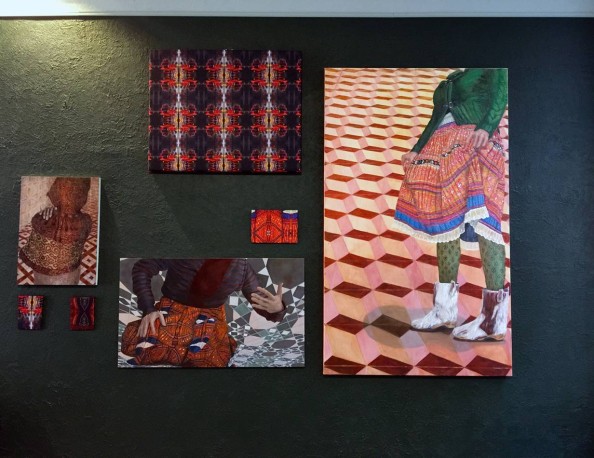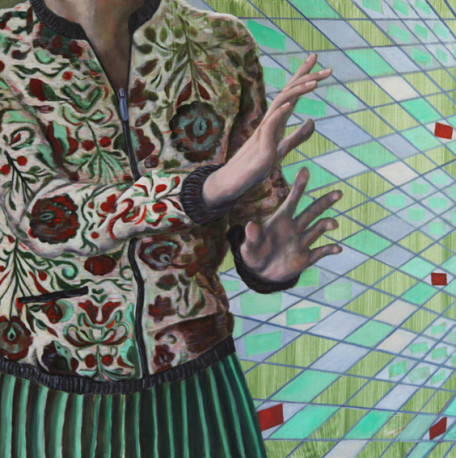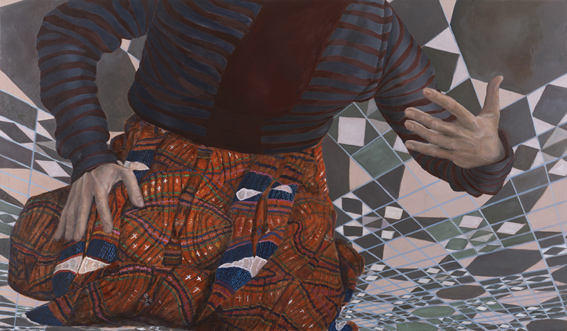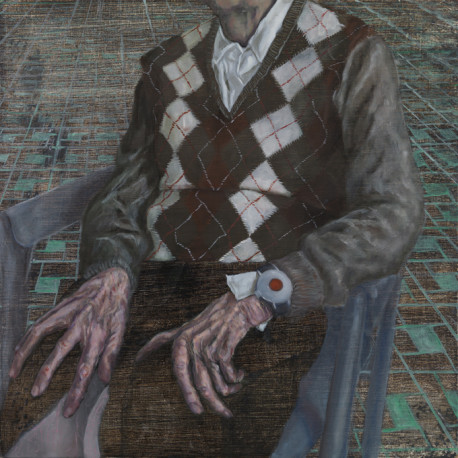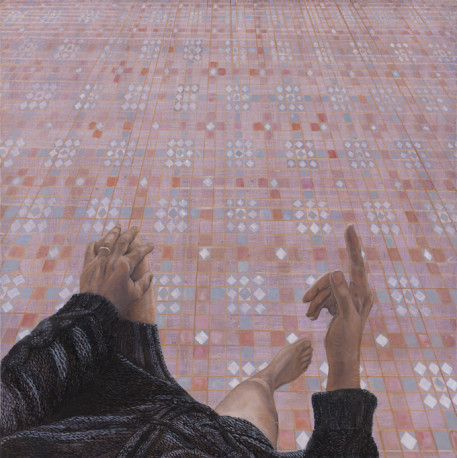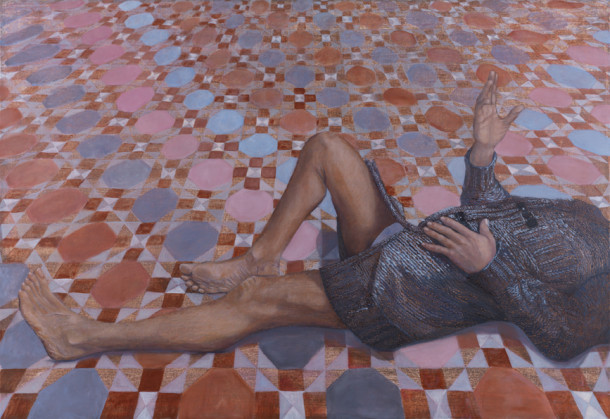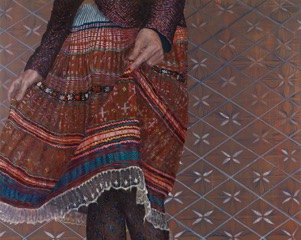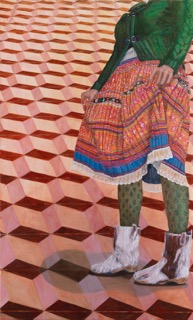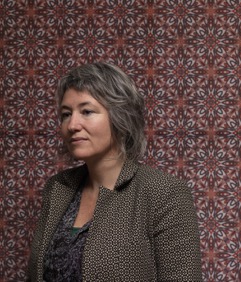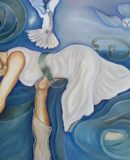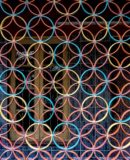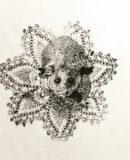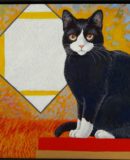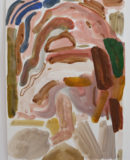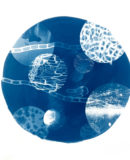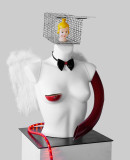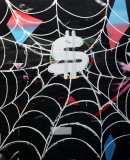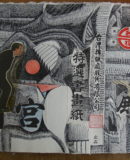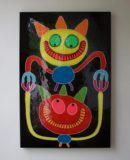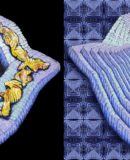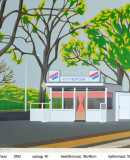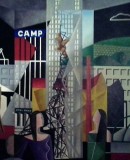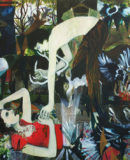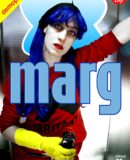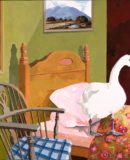World Fine Art Professionals and their Key-Pieces, 92 - José Krijnen
World Fine Art Professionals and their Key-Pieces, 92 – José Krijnen
The gesture is central in José Krijnen’s artwork. The gesture is well known in art history. You can find the human gesture in Roman statues and Christian mosaics. In Romance and in particular expressionism painterly gesture was used programmatically. José Krijnen created her own sign language by painting parts of people.
There is a lot of attention for expression of fabric, structures and patterns. I talk to her at the show Circular Argument in Sis Josip Gallery. Circular Argument, circular reasoning, refers to the transformation of fabric to painted representation, of which then a new fabric is made, which then is painted again. In this way, José creates her own world, where various textures/materials tell different stories.
The hands
On the dark green walls of the gallery around us large format paintings are hanging with figures in colorful attire with no heads and hands making a gesture. In the background of the person is a multicolored geometric pattern, indicating a tile floor with no horizon. In the doorway I saw a mannequin in this colorful dress with the head covered with knit fabric.
José Krijnen explains: “The hands are the starting point. They make a gesture. I wonder: is this gesture universal or individual? Whatever it is, it is understood, it is universal communication. In different times and contexts there is another meaning. Nothing is as ambiguous as the human gesture.” A whole development preceded the way the paintings are drawn up and presented – in combination with fabrics and knits. José graduated last year at the Royal Academy of Art in The Hague.
Isenheim Altar
In the second year, José with other students was asked to make copies and an updated translation of the Isenheim Altar, a late Gothic triptych painted by Matthias Grünewald in the years 1511-1517. The Isenheim Altar consists of nine panels “It is about the resurrection. It is an emotionally intense piece. It actually looks quite modern. We as students have indulged in those copies. We could exhibit in the Religious Museum in Uden. The Isenheim Altar was the most fun thing I’ve done in the Academy.”
She copied many fragments of altarpieces. “Then the human gesture became my theme. One of the most beautiful pieces was the handwringing Mary with tears dripping down. In these hands is the ambiguity. Is she pinching or praying? That touched me.” She made a personal version with her neighbour Youri in the same position as Mary, with hands folded piously. That work she points out as her key work. “When I was working, I saw everyone with hands together, in the train, in a conversation etc. It is a form of concentration, it can also be praying. Many people in China were sitting like that, with their hands together while in China there is no praying in the western way.”
Clippings
In the third year she painted praying people and also made a film on this theme that she projected on a wall. Of one person she made three Mary’s. In the second half of the third year she was Artist in Residence in China, Xiamen. ”Every farmer over there can make splendid clippings. You see them everywhere. It is also taught as a subject at the academy.” José was delighted with the simplicity and at the same time the wealth of the clippings. Eventually she has stuck a stack of red sheets and started going to cut this. It became a series of patterns of 6 meters long and 4 meters wide. For the exhibition the clipping was hung on the ceiling with many wires. It swayed in the wind.
In the fourth year she started to draw on the basis of the cutting patterns to return to the gesture. She didn’t show heads anymore, because it was about the idea of the gesture. And behind the depicted persons without heads came back Chinese templates, translated into patterns. “Patterns are a personal symbolism for me. It is a form of abstraction that I experience as vital. At the same time it gives the viewer space for his own story. The gesture became wedged in the patterns and counter-patterns, for example in the clothes. The friction between the patterns and structures suited me perfectly. A gesture is a pattern in the sense of a social conditioning that simultaneously has something special. Because the human body is concerned, it is always vulnerable.”
Into the space
“In the final year you’ll get an own studio, this applies for all the students. I made some paintings with a gesture and felt the need to do more with it. I started pulling things out of these paintings. I actually found that much more texture and pattern could resonate. I made a pattern on the wall, above the painting, beneath the painting. The fabric (illusion) from my painting I transformed back into a real fabric and the jersey became a ‘free-style-knit’.”
Polyphonic stories
“I started to make these fabrics because I had such an incredible fun in painting fabric expression. I was a regular at the fashion department because I was in the academy’s participation committee with the workshop manager. We had to consult regularly. The fashion department at the academy is – bluntly said – totally cool. And so I went there for printing fabrics. In this studio I was thinking much more than before about the formal characteristics of a painting. Rhythm, surfaces, repetition, the significance of the material. My workspace and the objects in it became a box of blocks that I was rearranging all the time.” For her final exam José put several large paintings with painted perspectives on the wall. The perspective of the combination deviated a bit from the perspective in the separate paintings, a significant tilting.
Humanist counselor
José Krijnen went relatively late to the Academy. She worked, and still works as a humanist counselor. She studied Humanism. “In my work I am always busy with people and their stories. The talks are about existential questions like life and death, guilt and shame, freedom and servitude.” Now she’s just a year artist. “Although, artist I find more an attitude. You have a need – coming from that attitude – to create / to communicate with an artistic product.”
It is clear that she owes much to the Royal Academy. You can experiment a lot and you get a good response, she says. Her study doesn’t stop, she wants to improve her skills in painting and textiles, and is now going to take a master class in the Textile Museum in Tilburg. She also delves into painting with egg tempera. Meanwhile, she has only exhibited after her graduation. “I had to work as hard this year as during my final exam. Time and again getting the rooms filled. Now she has her first solo exhibition. “I find this the most beautiful exhibition of this year, my work fits well in the room, with that dark green walls and wood panelling. By the way it is presented it is also an installation. I’m having fun, as in my studio at ‘school’.”
Professor Cheng
In September she goes for an exhibition to Poland, to Krakow. An art historian invited her. And a Chinese professor of art theory, Professor Cheng, wrote an article about her work in Chinese. See: http://bit.ly/1ru3BI7. “Professor Cheng said: ‘Your work is intertextual. You manage to find a language that transcends time and context and is nevertheless topical.’”
http://ifthenisnow.eu/nl/verhalen/de-wereld-van-de-haagse-kunstenaar-57-jose-krijnen
Disclaimer: The views, opinions and positions expressed within this guest article are those of the author Walter van Teeffelen alone and do not represent those of the Marbella Marbella website. The accuracy, completeness and validity of any statements made within this article are not guaranteed. We accept no liability for any errors, omissions or representations. The copyright of this content belongs to Walter van Teeffelen and any liability with regards to infringement of intellectual property rights remains with the author.

